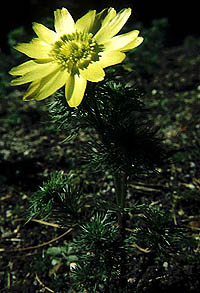Pheasant's eye, Summer adonis
Adonis vernalis This beautiful flower grows on dry meadows and grasslands of Central, South and East Europe, Canada and Siberia early in the spring. |
It is named after the Phoenician and Assyrian god of the resurrection of nature, Adon. There is another, more romantic Greek legend about a handsome lad with whom the goddess of love Aphrodite was in love. Once, while they were hunting, a wild boar hurt Adonis. He died and Aphroditaâs tears made a beautiful flower grow at that place.
The pheasantâs eye is a perennial plant with strong roots. It is up to 40 cm long, has many stems and serrated leaves. Its epigeous parts contain toxic cardiac glycosides similar to those of digitalis (cymarine, adonitoxin, adonidoside, etc.); its roots are also poisonous, still being researched. |
|
The poisoning is characterized by refractory vomiting and diarrhea, slow pulse, collapse and, if no treatment is received, ceasing of heart function. A number of medical products were produced from adonis in the past but they have now been replaced by modern synthetic medicines.

